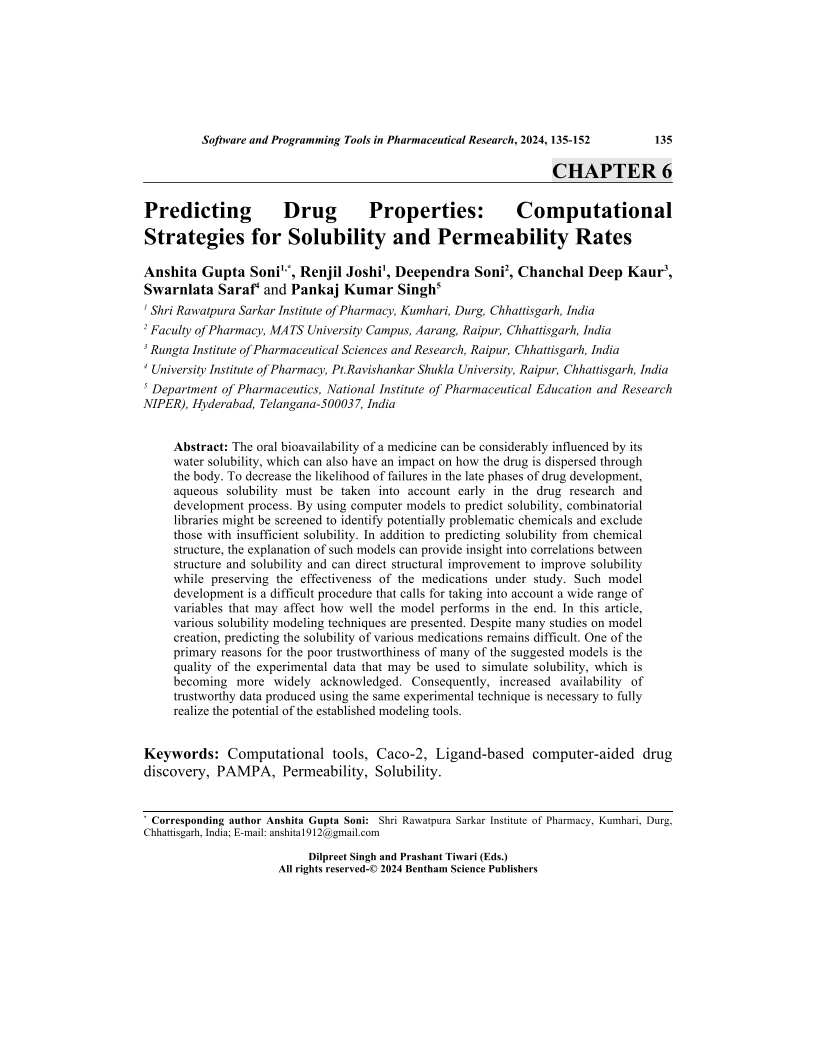Predicting Drug Properties: Computational Strategies for Solubility and Permeability Rates

- Authors: Anshita Gupta Soni1, Renjil Joshi2, Deependra Soni3, Chanchal Deep Kaur4, Swarnlata Saraf5, Pankaj Kumar Singh6
-
View Affiliations Hide AffiliationsAffiliations: 1 Shri Rawatpura Sarkar Institute of Pharmacy, Kumhari, Durg, Chhattisgarh, India 2 Shri Rawatpura Sarkar Institute of Pharmacy, Kumhari, Durg, Chhattisgarh, India 3 Faculty of Pharmacy, MATS University Campus, Aarang, Raipur, Chhattisgarh, India 4 Rungta Institute of Pharmaceutical Sciences and Research, Raipur, Chhattisgarh, India 5 University Institute of Pharmacy, Pt.Ravishankar Shukla University, Raipur, Chhattisgarh, India 6 Department of Pharmaceutics, National Institute of Pharmaceutical Education and Research NIPER), Hyderabad, Telangana 500037, India
- Source: Software and Programming Tools in Pharmaceutical Research , pp 135-152
- Publication Date: March 2024
- Language: English
Predicting Drug Properties: Computational Strategies for Solubility and Permeability Rates, Page 1 of 1
< Previous page | Next page > /docserver/preview/fulltext/9789815223019/chapter-6-1.gif
The oral bioavailability of a medicine can be considerably influenced by its water solubility, which can also have an impact on how the drug is dispersed through the body. To decrease the likelihood of failures in the late phases of drug development, aqueous solubility must be taken into account early in the drug research and development process. By using computer models to predict solubility, combinatorial libraries might be screened to identify potentially problematic chemicals and exclude those with insufficient solubility. In addition to predicting solubility from chemical structure, the explanation of such models can provide insight into correlations between structure and solubility and can direct structural improvement to improve solubility while preserving the effectiveness of the medications under study. Such model development is a difficult procedure that calls for taking into account a wide range of variables that may affect how well the model performs in the end. In this article, various solubility modeling techniques are presented. Despite many studies on model creation, predicting the solubility of various medications remains difficult. One of the primary reasons for the poor trustworthiness of many of the suggested models is the quality of the experimental data that may be used to simulate solubility, which is becoming more widely acknowledged. Consequently, increased availability of trustworthy data produced using the same experimental technique is necessary to fully realize the potential of the established modeling tools.
-
From This Site
/content/books/9789815223019.chapter-6dcterms_subject,pub_keyword-contentType:Journal105

